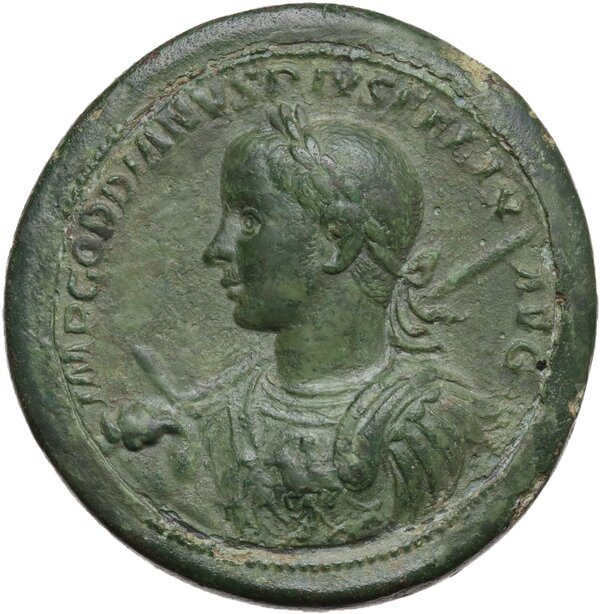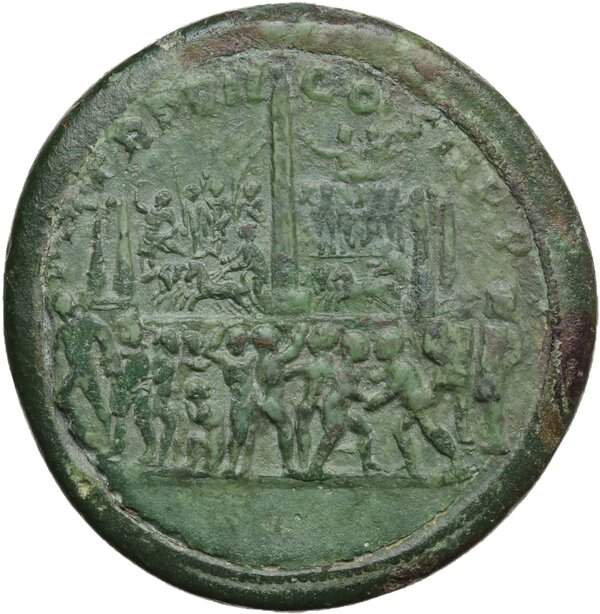The Circus Maximus


Lot 525:
Gordian III (238-244 ). AE Bimetallic Medallion, from end of July 244 AD (final issue). Obv. IMP GORDIANVS PIVS FELIX AVG. Laureate, draped and cuirassed bust left, holding spear over right shoulderTR P VII. Rev. TR P VII COS II PP. View of the interior of the Circus Maximus, obelisk in the center, three metae to either side, two chariots racing around spina; in the foreground, from left to right, wounded gladiator being led away by an attendant, two boxers boxing, a pair of pancratiastae, two wrestlers, two gladiators; in the background, Gordian in a chariot drawn by six horses, Victory standing alongside placing wreath on Gordian's head, the chariot being preceded by three soldiers carrying palms. Gnecchi 27, pl. 104, 10 ; Grueber p. 46, 5. 52.90 g. 38.00 mm. RRR. Excessively rare and of tremendous importance and fascination. From masterfully engraved and detailed dies, with an enchanting Gordian's portait in high relief, of exquisite style. Lovely light emerald green patina. Gently smoothed, otherwise. about EF. The Circus Maximus (“largest” or “greatest circus”) lived up to its grand name, with modern scholars estimating that the building could hold some 150,000 spectators, or roughly three times the number of people that the Colosseum could accommodate (Pliny’s statement that the Circus could hold 250,000 appears to be an exaggeration).
According to Pliny, the Circus was established during the reign of the Tarquinius Priscus, Etruscan king of Rome (circa 616-579 BC), although a permanent structure may not have existed until 329 BC, when the starting gates (carceres) were erected. Here we have a representation of various diversions going on, in the area of the great structure in question, we see the metae, whose conical terminations are surmounted by an egg-like form, symbolical of the ovum Castoris, Castor being patron of the desultores, or horse riders of the circus. A lofty obelisk (one of those brought from Egipt, and dedicated to the Sun) rises in the centre of the spina; on the further side of which a biga and a quadriga are running. Still further in the distance, to the left, are three togate figures braring palm branches, the foremost of which is holding up his right hand. On the right is a figure in imperial
habiliments, crowned by a Victory from behind, and standing in a triumphal car drawn by six horses; whilst in the foreground a troop of gladiators, wrestlers, and other athletes, are in diverse ways contesting with each other; the whole number of figures crowded into the narrow round of the medallion is seventeen.
According to Pliny, the Circus was established during the reign of the Tarquinius Priscus, Etruscan king of Rome (circa 616-579 BC), although a permanent structure may not have existed until 329 BC, when the starting gates (carceres) were erected. Here we have a representation of various diversions going on, in the area of the great structure in question, we see the metae, whose conical terminations are surmounted by an egg-like form, symbolical of the ovum Castoris, Castor being patron of the desultores, or horse riders of the circus. A lofty obelisk (one of those brought from Egipt, and dedicated to the Sun) rises in the centre of the spina; on the further side of which a biga and a quadriga are running. Still further in the distance, to the left, are three togate figures braring palm branches, the foremost of which is holding up his right hand. On the right is a figure in imperial
habiliments, crowned by a Victory from behind, and standing in a triumphal car drawn by six horses; whilst in the foreground a troop of gladiators, wrestlers, and other athletes, are in diverse ways contesting with each other; the whole number of figures crowded into the narrow round of the medallion is seventeen.
Start price € 5000
Current price € 15500
Bids: 14
No more available for sale.
Current price € 15500
Bids: 14
No more available for sale.





